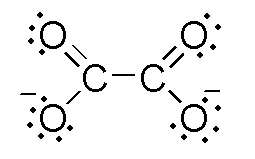
A bidentate ligand is:
A. Oxalate ion
B. Carbon monoxide
C. Nitronium ion
D. Water
Answer
546k+ views
Hint: A ligand is defined as the species which donates its pair of electrons to the central metal atom to form coordination complex. A bidentate ligand is the one which has two binding sites.
Complete step by step answer:
In coordination chemistry, the coordination complexes are formed where the central metal atom is surrounded by ligands.
The ligands are defined as atoms or groups of atoms which can donate their lone pairs to the central metal to form the coordination complex.
The ligands can be classified according to their binding site to the central metal atom.
The classification is shown below.
(1) Monodentate ligands: Monodentate ligands are defined as those ligands which have only one binding site.
(2) Bidentate ligands: Bidentate ligands are defined as those ligands which have two binding sites.
(3) Tridentate ligands: Tridentate ligands are defined as those ligands which have three binding sites.
From the given option nitronium ion, carbon monoxide ion, and water are examples of monodentate ligand.
The oxalate ion is the example of bidentate ligand.
The structure of oxalate ions is shown below.

Here, the ligand binds with two sites to the central metal atom.
So, the correct answer is Option A.
Note: The ligands can be anion, cation or neutral atom or group. In coordination complex, the ligands act as lewis base (donor group) and the central metal atom act as lewis acid (acceptor group). The Ambidentate ligand is said to be ligand which have more than one donor groups.
Complete step by step answer:
In coordination chemistry, the coordination complexes are formed where the central metal atom is surrounded by ligands.
The ligands are defined as atoms or groups of atoms which can donate their lone pairs to the central metal to form the coordination complex.
The ligands can be classified according to their binding site to the central metal atom.
The classification is shown below.
(1) Monodentate ligands: Monodentate ligands are defined as those ligands which have only one binding site.
(2) Bidentate ligands: Bidentate ligands are defined as those ligands which have two binding sites.
(3) Tridentate ligands: Tridentate ligands are defined as those ligands which have three binding sites.
From the given option nitronium ion, carbon monoxide ion, and water are examples of monodentate ligand.
The oxalate ion is the example of bidentate ligand.
The structure of oxalate ions is shown below.

Here, the ligand binds with two sites to the central metal atom.
So, the correct answer is Option A.
Note: The ligands can be anion, cation or neutral atom or group. In coordination complex, the ligands act as lewis base (donor group) and the central metal atom act as lewis acid (acceptor group). The Ambidentate ligand is said to be ligand which have more than one donor groups.
Recently Updated Pages
Master Class 12 Business Studies: Engaging Questions & Answers for Success

Master Class 12 Economics: Engaging Questions & Answers for Success

Master Class 12 English: Engaging Questions & Answers for Success

Master Class 12 Maths: Engaging Questions & Answers for Success

Master Class 12 Social Science: Engaging Questions & Answers for Success

Master Class 12 Chemistry: Engaging Questions & Answers for Success

Trending doubts
What are the major means of transport Explain each class 12 social science CBSE

Which are the Top 10 Largest Countries of the World?

Draw a labelled sketch of the human eye class 12 physics CBSE

How much time does it take to bleed after eating p class 12 biology CBSE

Explain sex determination in humans with line diag class 12 biology CBSE

Differentiate between homogeneous and heterogeneous class 12 chemistry CBSE




